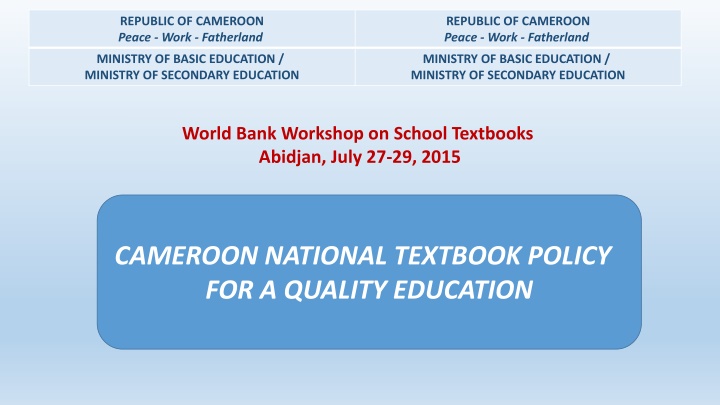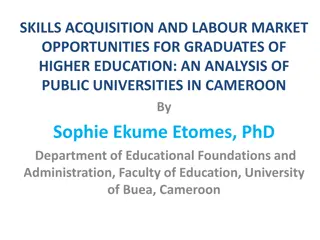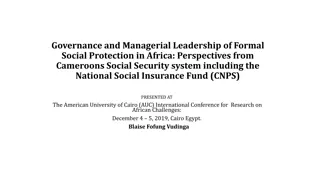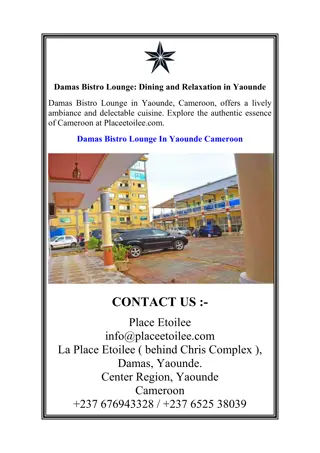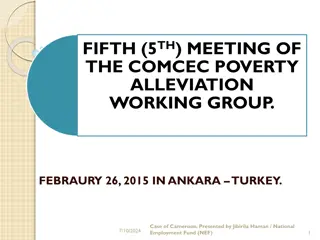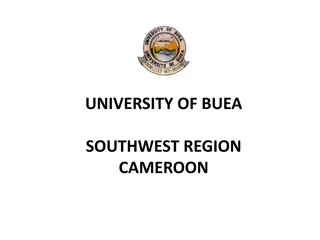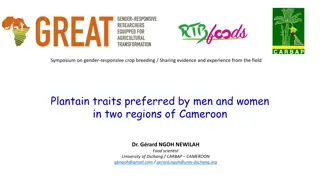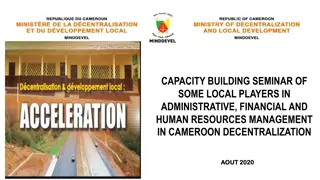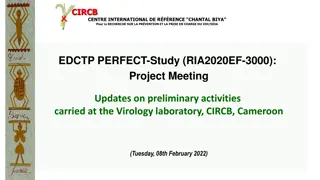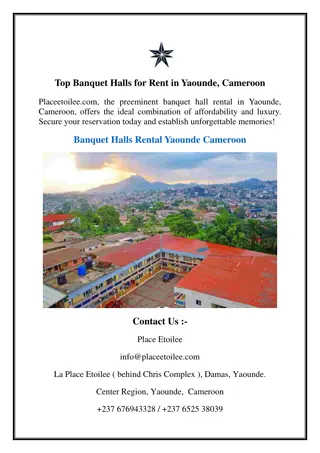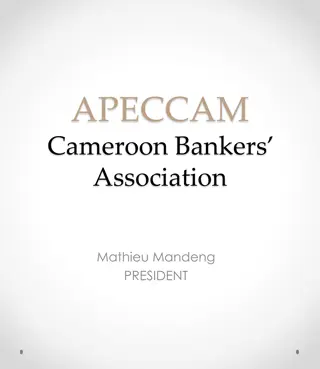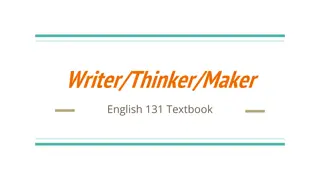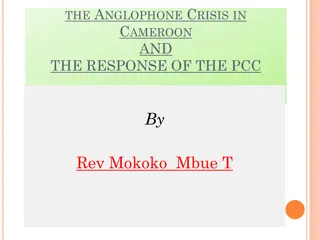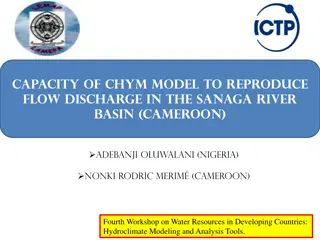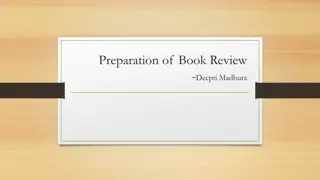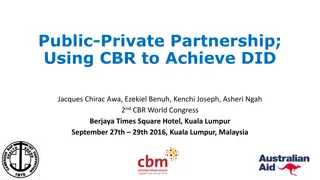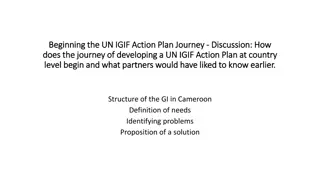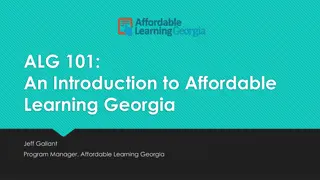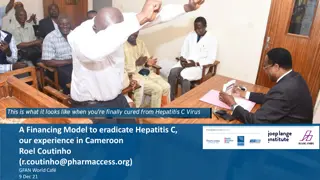CAMEROON NATIONAL TEXTBOOK POLICY
Cameroon's National Textbook Policy aims to enhance education quality by addressing historical influences, current challenges, and future perspectives. The policy outlines initiatives to improve access, content, and distribution of textbooks in the diverse educational landscape of Cameroon.
Download Presentation

Please find below an Image/Link to download the presentation.
The content on the website is provided AS IS for your information and personal use only. It may not be sold, licensed, or shared on other websites without obtaining consent from the author.If you encounter any issues during the download, it is possible that the publisher has removed the file from their server.
You are allowed to download the files provided on this website for personal or commercial use, subject to the condition that they are used lawfully. All files are the property of their respective owners.
The content on the website is provided AS IS for your information and personal use only. It may not be sold, licensed, or shared on other websites without obtaining consent from the author.
E N D
Presentation Transcript
REPUBLIC OF CAMEROON Peace - Work - Fatherland REPUBLIC OF CAMEROON Peace - Work - Fatherland MINISTRY OF BASIC EDUCATION / MINISTRY OF SECONDARY EDUCATION MINISTRY OF BASIC EDUCATION / MINISTRY OF SECONDARY EDUCATION World Bank Workshop on School Textbooks Abidjan, July 27-29, 2015 CAMEROON NATIONAL TEXTBOOK POLICY FOR A QUALITY EDUCATION
Presentation Outline Presentation Outline Overview of Cameroon Where Have We Come From? Where Are We Now? Key Aspects of the Textbook Policy Perspectives: What Are We Aiming For?
Overview of Overview of Cameroon Cameroon Located at the bottom of the Gulf of Guinea in Central Africa, Cameroon is a transitional location between North, West, East, and Southern Africa. Due to this location, Cameroon is very diverse, both in the human and natural realms. This diversity inspired the nickname Miniature Africa. French and English are the country s two official languages, a legacy of French and English colonization.
Overview of Cameroon (continued) Overview of Cameroon (continued) Area: 475,000 km2, with a population of 20 million inhabitants with an average age of 22.1 years; GDP per capita: 1224 USD ; 43.6% of the population is under 15 years old; There are 4,136,912 primary-school-aged children, of which 1,934,436 are girls (46.76%) ; Gross school enrollment rate of 118%, 113% for girls, and the net rate of 93.5%; The primary school completion rate is 75%; There are 94,328 primary-school teachers, 49,588 of which are women; There are 18,135 primary schools, 11,906 of which are public.
Where Have We Come From? Where Have We Come From? When Cameroon gained independence, it was part of OCAM and its education system used, with help from the monolithic political system, the same textbooks as all of the other francophone countries (Mamadou and Bineta), with an exception in Catholic schools, which used their own; Once it left OCAM, Cameroon created the Center for Textbook and Teacher Guide Publication and Production (CEPMAE - Centre d'Edition et de Production de Manuels et Auxiliaires de l'Enseignement) to produce and distribute books to schools. The book title was the same throughout the entire system; In 1970, with support for la Francophonie (ACCT) the government established the Center for Publication and Production for Education and Research (CEPER - Centre d'Edition et de Production pour l Enseignement et la Recherche) to replace the CEPMAE. The book title was still the same throughout the entire education system and was sold at an affordable price; The situation changed in the 1990s with democratization and structural adjustment policies.
Where Have We Come From? Where Have We Come From? In 1990 Cameroon was placed under structural adjustment. Among the consequences: 60% of public servants had their salaries reduced; Layoffs of public servants; The closure of state enterprises. The social situation worsened, unemployment went up, poverty grew; Parents were no longer able to provide their children with textbooks, which still had a high price.
Where Are We Now? Where Are We Now? A study conducted in 2012 on availability and accessibility revealed an average ratio of 1 book per 12 students in the country; Education quality suffers: "A recent study conducted on a sample of 4th- grade classes (CM1) produced a very alarming result: 49% of public- school students have great difficulty reading (they can only read a few syllables but not a word or cannot read at all). 26.6% of public-school students are mute readers, unable to read even a syllable .1 1Study commissioned by the MINEDUB and conducted by Sofreco
Where Are We Now? Where Are We Now? In the face of deteriorating quality of education, it has proven necessary to reverse the trend. This was reflected by government initiatives supported by various PTF, namely: -PASE (World Bank) - PAQUEB (Islamic Bank) - Program C2D (AFD) - HIPC (Multilateral) The Strategy Document for the Education and Training Sector endorsed in 2013 by the PTF plans for the free distribution of textbooks to public primary schools. In line with this option: The Global Partnership for Education gave a grant of 53.6 million USD supervised by the World Bank. This donation was implemented by the Education Quality and Equality Improvement Program in Cameroon (PAEQUE - Programme d Am lioration de l quit et de la Qualit de l Education).
Where Are We Now? Where Are We Now? The PAEQUE provides for the provision of textbooks to public primary schools over a period of 3 years, for pupils in the first three grades, with priority given to rural and disadvantaged areas; The plan is to achieve a ratio of 1 textbook per 3 students in the core subjects; A plan for teaching/learning reading in primary school is included; Initial and continuing training for teachers in textbook use is also planned.
Key Aspects of the National Policy on Key Aspects of the National Policy on Textbooks Textbooks In 2000, the democratization process was accompanied by the liberalization that did not spare the textbook sector: There is now a plurality of titles, on the condition that they comply with the official programs; The State monopoly made room for private publishers. A draft bill of the National Textbook and Teaching Materials Policy was developed with the support of the AFD (2012) under the authority of the Prime Minister's services with the participation of the ministries of basic education, secondary education, and commerce. It is awaiting validation.
Key Aspects of Key Aspects of the National Policy on the National Policy on Textbooks Textbooks ( (continued continued) ) This policy, which sanctions liberalization and hence the disengagement of the State, promotes: Free competition between publishers; Multiple title choices at the primary and secondary levels; Selection of titles at the national level by the CNAMSMD; Annual publication of a national list of approved textbooks; Choice of titles at the school level; Endogenous publication and co-publication of textbooks; Distribution of textbooks by booksellers and private publishers; Strengthening of professional capacity of executives involved in the field of school textbooks.
Key Aspects of the National Policy on Textbooks (continued) Key Aspects of the National Policy on Textbooks (continued) The National Council for the Accreditation of School Textbooks and Teaching Materials (CNAMSMD - Conseil National d Agr ment des Manuels Scolaires et des Mat riels Didactiques) was created to provide advice and technical assistance in the implementation of the textbook policy. Among other things, it is responsible for: Annual evaluation of textbook and teaching material needs; Evaluation of textbooks in accordance with procedures and criteria; Establishing a list of 5 approved textbooks by subject and class; Conducting a survey every 3 years on the availability and accessibility of textbooks.
Summary of Contributions, 2000 Summary of Contributions, 2000 2015 2015 Number of Titles Acquired Sources of Financing Amounts 1,733,000.28 USD PAEQUE (SMEs) 1,090,184 C2D (AFD) 25,848 600 000 USD Islamic Development Bank - IDB World Bank PPTE (free distribution primary school) Government 52,000 200,000 USD textbook program in 2,500,000 8,000,000 USD 72,000 360 000 USD 10,893,000.28 USD TOTAL
What Are We Aiming For? What Are We Aiming For? The quality of education is inextricably linked to the availability of educational materials, especially textbooks. It is therefore a matter of improving the quality by making textbooks accessible and available to all students at the right time, at an affordable cost, and with the required quality. Because of this, the Government is working on a national policy to reduce prices and improve textbook availability. This policy also promotes endogenous publishing and co-publication of textbooks. With this in mind, Cameroon hopes for contributions and technical support from all development partners so that the ultimate goal of 1 textbook per student in the core subjects can be reached by 2020.
